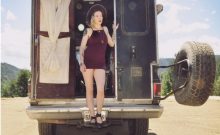Anyone who has lived on the road, for any length of time, will be able to tell you countless stories of breaking down on the side of the road or getting stranded in some far off boondocking spot. They will also tell you that your true adventure doesn’t begin until that happens. Now, I am not talking about ‘if you break down’, rather ‘when you break down’ because no matter how much time and effort you put into preparing for road life, it will happen. A tire will pop, a bearing will blow, or your fuel tank will run out. You cannot control when your vehicle breaks down on you, though, I can say from experience, it tends to happen at 2 am on a stormy night. The most important thing is your attitude and perspective in those situations.
Typically, there are two main reactions to a vehicle break down. You can get pissed off, kick the tire, and cuss into the wind, or you can take a deep breath, begin to understand the situation you are in, and look forward to the journey ahead. I realize the latter is not the natural reaction for most, but I want to argue that it should be. When a break down becomes a part of, rather than a hindrance to, the journey, a paradigm shift happens within us.
Around two years ago, I was on a 4-month trip, in an SUV with a good friend of mine, driving through Lake Powell in the summer heat. We intended to stop by the lake and head to a friend’s place, in Phoenix, the next day. Unfortunately, as we were driving, the temperature of the pavement overheated our transmission. Once we parked down by the lake, the gearbox locked up and we were stuck. After getting some information on how to fix the problem, we learned we needed to first get the transmission temperature down and then get to a mechanic to flush the system.

We walked to the nearby ranger station, while our SUV was cooling down, and asked a park ranger where the nearest mechanic shop was that could help us. To our disappointment, the ranger proceeded to tell us, we would need to get to Kanab, Utah, approximately 300 miles away by highway and around Capital Reef NP. That, of course, was too far, and we did not want to risk the distance so we asked if there was any other way. The ranger gave us a brochure mapping out the ‘Burr Trail’. She told us the trail was an old cattle route but was later turned into a scenic dirt road through the backside of Capital Reef NP. It ended up being half the distance to Kanab and would send us through some of the most beautiful backcountry in southern Utah. The ranger even said that she drove the road everyday after work to get home and would be around 2 hours behind us, just in case we didn’t make it.
I don’t share this story to suggest that every time you break down you will end up on some amazing spiritual journey or meet John Legend and stay at his house, but I will suggest that you will experience nature and meet people you would have otherwise driven by. We never planned on breaking down, but if I had not taken a positive attitude, I could have very well missed out on what became one of my favorite memories from the road. This is what can happen when you allow a breakdown to become a part of your story and not feel like it is trying to end it. When living on the road, I like to think of my vehicle as a character in my life story. Not only do I make decisions about my day-to-day direction but, at times, my vehicle does as well. Honestly, sometimes that hunk of metal knows better than I do.
When you live on the road and let go of ‘your plans and perceptions’ it will begin to lead you on a journey toward a radically different appreciation for the community and nature around you. The road is no longer about destinations but rather presence. My story of living on the road can be summed up in a quote I wrote a few years ago. “It’s not about the number of miles you drive, but rather the people who live each and every mile along the way. Let the road mold you and teach you about yourself, humanity, and nature.”
Michael Fuehrer – Navigationnowhere





